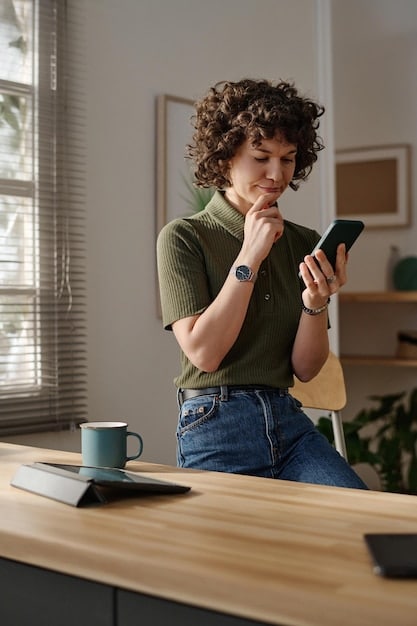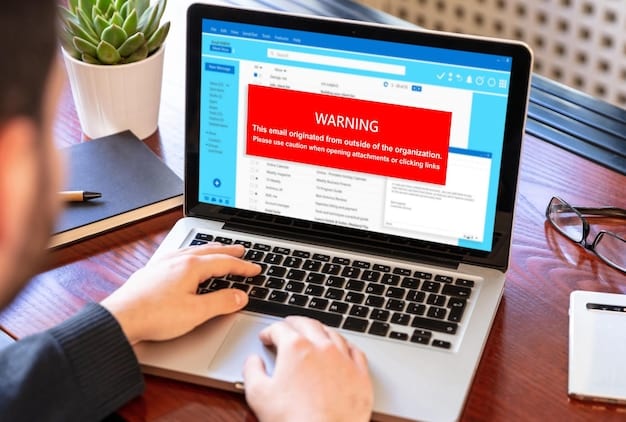Social Media Privacy: 7 Settings to Adjust Today for US Users

Social media privacy is essential for protecting your personal information; adjusting key settings across platforms like Facebook, Instagram, Twitter, and TikTok can significantly enhance your control over who sees your data and how it’s used.
Navigating the world of social media requires a keen understanding of privacy settings. In today’s digital age, safeguarding your personal information is more crucial than ever. This article will guide you through social media privacy, highlighting seven essential settings you should adjust today to protect your data and maintain your online security specifically for users in the US.
Understanding the Importance of Social Media Privacy
Social media platforms have become integral to our daily lives, connecting us with friends, family, and the world at large. However, this connectivity comes with inherent risks to our privacy. Understanding these risks is the first step in taking control of your digital footprint.
Why Privacy Matters on Social Media
Privacy settings on social media are crucial because they determine who can see your posts, personal information, and activities. Without proper adjustments, your data could be exposed to unintended audiences, including marketers, scammers, and even potential employers. Protecting your privacy helps maintain your reputation, prevent identity theft, and control the narrative of your online presence.
The Risks of Ignoring Privacy Settings
Ignoring privacy settings can lead to several negative consequences. Your personal information, such as your address, phone number, and daily routines, could be used for malicious purposes. Additionally, companies might collect and sell your data to third parties for targeted advertising, potentially leading to unwanted solicitations and a loss of control over your personal information.

Ultimately, understanding the importance of privacy settings empowers you to take control of your online identity and protect yourself from potential risks, ensuring a safer and more secure social media experience.
Facebook Privacy Settings You Need to Change
Facebook, being one of the largest social media platforms, offers a multitude of privacy settings that can be tailored to your preferences. Adjusting these settings can significantly enhance your privacy and control who sees your content.
Limiting the Visibility of Your Posts
One of the first settings you should adjust is the visibility of your posts. You can choose who can see your future posts—options include “Public,” “Friends,” “Friends Except…,” and “Only Me.” Limiting your audience to “Friends” or a custom list can help protect your content from being viewed by strangers.
Reviewing and Editing Your Past Posts
Facebook also allows you to review and edit your past posts. The “Activity Log” is a useful tool to check what you’ve shared and who can see it. You can change the audience of individual posts or use the “Limit Past Posts” feature to change the audience of all your public posts to “Friends.”
- Go to Settings & Privacy > Privacy.
- Click “Limit the Audience for Posts You’ve Shared with Friends of Friends or Public?”
- Click “Limit Past Posts.”
By regularly reviewing and editing your past posts, you can ensure that your older content aligns with your current privacy preferences.
Adjusting your Facebook privacy settings is a proactive step you can take to protect your personal information and control your online presence. By limiting the visibility of your posts and reviewing your past activity, you can ensure a safer and more secure social media experience.
Instagram Privacy Settings: Keeping Your Account Secure
Instagram, a visual platform, also offers several privacy settings that can help you control your content and protect your account. From making your account private to controlling who can tag you, understanding these settings is crucial.
Making Your Account Private
One of the most effective ways to enhance your Instagram privacy is by making your account private. When your account is private, only approved followers can see your posts, stories, and profile. This prevents strangers from accessing your content without your permission.
Controlling Who Can Tag You
Instagram’s tagging feature can be a double-edged sword. While it’s great for sharing fun moments with friends, it can also expose you to unwanted attention. You can control who can tag you in photos and videos by adjusting your tagging settings. This allows you to manually approve tags before they appear on your profile, giving you greater control over your online presence.
- Go to Settings > Privacy > Tags.
- Choose who can tag you: “Everyone,” “People You Follow,” or “No One.”
- Enable “Manually Approve Tags” to review tags before they appear on your profile.
By making your account private and managing your tagging settings, you can create a more secure and controlled Instagram experience, limiting exposure to unwanted attention and protecting your personal information.
Twitter (X) Privacy: Safeguarding Your Tweets
Twitter, now known as X, is a platform where public discourse thrives. However, it’s essential to manage your privacy settings to protect your tweets and personal information. Adjusting these settings can help you control who sees your content and interacts with you.
Protecting Your Tweets
Twitter allows you to protect your tweets, making them visible only to your approved followers. When you protect your tweets, new followers must request permission to follow you, and your tweets won’t appear in public search results. This is particularly useful if you want to share your thoughts with a smaller, more select audience.
Managing Direct Messages (DMs)
Direct Messages (DMs) on Twitter can be a gateway for unwanted communication. You can manage who can send you DMs by adjusting your settings. Choosing to receive DMs only from people you follow can reduce spam and unsolicited messages, creating a more controlled and pleasant messaging experience.

By protecting your tweets and managing your DM settings, you can maintain a more private and secure Twitter presence, ensuring that your content is viewed only by your intended audience and reducing unwanted interactions.
TikTok Privacy: Personalizing Your Experience
TikTok, known for its short-form videos, also offers several privacy settings that can help you personalize your experience and protect your content. Understanding these settings is particularly important given TikTok’s popularity among younger users.
Controlling Who Can See Your Videos
TikTok allows you to control who can see your videos. You can set your account to “Private,” which means only approved followers can view your content. Alternatively, you can adjust the privacy settings for individual videos, choosing who can watch them—options include “Everyone,” “Friends,” or “Only Me.” This flexibility allows you to tailor your content to different audiences.
Limiting Who Can Comment or Duet with Your Videos
TikTok offers granular control over who can interact with your videos. You can limit who can comment on your videos, preventing unwanted or inappropriate comments. Additionally, you can restrict who can duet or stitch with your videos, preventing others from using your content without your permission. These settings are essential for maintaining a positive and safe online environment.
Two-Factor Authentication: An Extra Layer of Security
Regardless of the social media platform, enabling two-factor authentication (2FA) is a critical step in protecting your account. 2FA adds an extra layer of security by requiring a second verification method, such as a code sent to your phone, in addition to your password.
How Two-Factor Authentication Works
When you enable 2FA, logging into your account requires two forms of identification: something you know (your password) and something you have (your phone or another device). This makes it significantly harder for hackers to gain unauthorized access to your account, even if they manage to obtain your password.
Enabling 2FA on Different Platforms
Most social media platforms offer 2FA as a standard security feature. The setup process typically involves linking your phone number to your account and choosing a verification method, such as SMS codes or authentication apps. Once enabled, you’ll receive a code each time you log in from a new device, ensuring that only you can access your account
- Navigate to the security settings of the social media platform.
- Find and enable Two-Factor Authentication (2FA).
- Follow the prompts to link your phone number or set up an authentication app.
Enabling two-factor authentication is a straightforward yet highly effective way to protect your social media accounts from unauthorized access, providing an extra layer of security against hacking and identity theft.
Regularly Reviewing Your Privacy Settings
Social media platforms constantly evolve, and their privacy settings are subject to change. Therefore, it’s essential to regularly review your privacy settings to ensure they align with your current preferences.
Why Regular Reviews Are Important
Regularly reviewing your privacy settings allows you to stay informed about any updates or changes to the platform’s policies. It also provides an opportunity to reassess your privacy preferences and make any necessary adjustments. Over time, your comfort level with sharing certain information may change, so it’s important to keep your settings up-to-date.
Tips for Conducting a Privacy Audit
Conducting a privacy audit involves systematically reviewing all your privacy settings on each social media platform. Start by checking your profile visibility, post visibility, tagging settings, and ad preferences. Also, review your connected apps and websites to ensure they still have the necessary permissions. Make sure to complete the audit every 3-6 months to stay on top of your privacy management.
Regularly reviewing your privacy settings is a continuous process that ensures your personal information remains protected and your online presence aligns with your evolving preferences. By staying proactive and informed, you can maintain control over your digital footprint and enjoy a safer social media experience.
| Key Aspect | Brief Description |
|---|---|
| 🔒 Profile Visibility | Control who can see your profile and posts on platforms like Facebook and Instagram. |
| 📲 Two-Factor Authentication | Enable to add an extra layer of security, requiring a second verification method. |
| 🏷️ Tag Settings | Manage who can tag you in photos and videos to prevent unwanted attention. |
| ✉️ Direct Message Control | Limit who can send you direct messages to reduce spam and unsolicited messages. |
[FAQ Section]
Frequently Asked Questions About Social Media Privacy
▼
Social media privacy is crucial because it protects your personal information from being accessed by unintended audiences, such as marketers, scammers, and potential employers. Proper privacy settings help maintain your reputation and prevent identity theft.
▼
To make your Facebook profile more private, adjust your post visibility settings to “Friends” or “Only Me.” Also, review and edit your past posts, and control who can tag you in photos and videos. These steps can significantly enhance your overall privacy.
▼
Two-factor authentication adds an extra layer of security to your accounts by requiring a second verification method, such as a code sent to your phone, in addition to your password. This makes it harder for unauthorized users to access your accounts.
▼
You should review your social media privacy settings regularly, ideally every 3-6 months. Social media platforms constantly evolve, and their policies are subject to change, making regular reviews crucial for staying informed and maintaining control over your privacy.
▼
On TikTok, you can set your account to “Private” so that only approved followers can view your content. Additionally, you can adjust privacy settings for individual videos, choosing who can watch them – “Everyone,” “Friends,” or “Only Me.”
Conclusion
Taking control of your social media privacy is essential in today’s digital landscape. By adjusting these seven key settings on platforms like Facebook, Instagram, Twitter (X), and TikTok, and enabling two-factor authentication, you can significantly enhance your online security and protect your personal information from unintended access.





